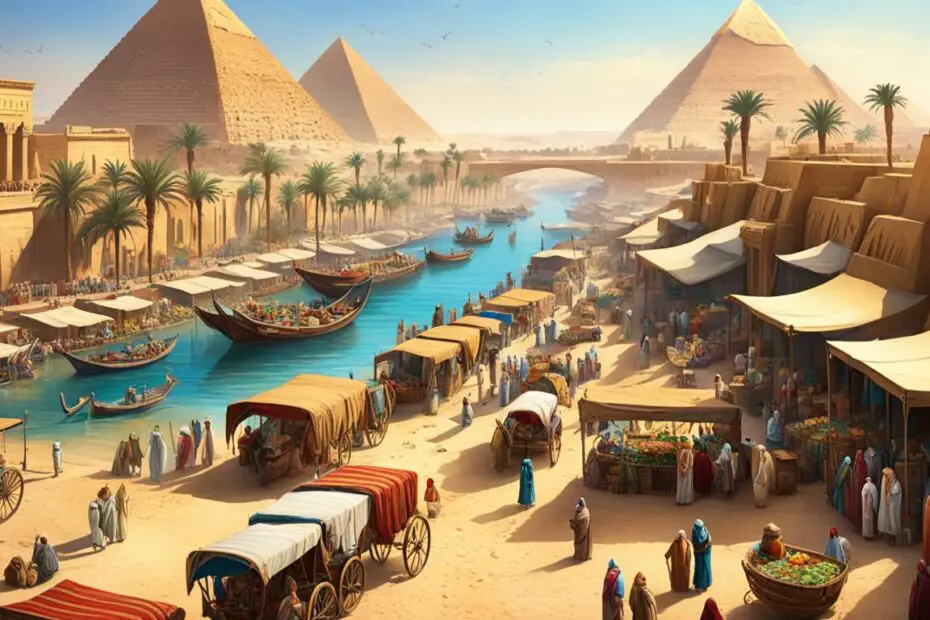Have you ever wondered how trade functioned in ancient Egypt? How did the ancient Egyptians conduct business without a formal currency system? Let’s explore the fascinating world of currency in ancient Egypt and uncover the secrets of their trade and economy. From bartering to the introduction of cash, ancient Egypt had a unique economic system that shaped their society and played a crucial role in their prosperity.
Trade played a vital role in the ancient Egyptian economy, providing necessary goods and luxury items not readily available in their rich land. While ancient Egyptians had an abundance of natural resources, trade was essential for maintaining a stable economy and cultural exchange. Join us as we delve into the history of ancient Egyptian trade, from local exchanges to international networks.
Trade in Ancient Egypt: From Local to International
Trade played a crucial role in the ancient Egyptian economy, facilitating the exchange of goods and resources with neighboring regions. The trade networks of ancient Egypt expanded from local to international, connecting different regions of the country and establishing relationships with Mesopotamia, the Levant, Libya, Nubia, and other lands.
Even before the unification of Egypt, trade existed between different regions of the country. During the First Dynasty, trade relations were established with Mesopotamia, paving the way for cultural exchanges and influences. The First Dynasty kings centralized trade operations in Memphis, creating a robust central government responsible for managing trade with neighboring regions.
The impact of Mesopotamia on Egyptian culture can be seen in various aspects, including art and religion. The exchange of ideas, goods, and customs enriched both civilizations and contributed to their development.
As trade expanded, Egypt established trading colonies in Canaan, Syria, and Nubia to facilitate commerce and strengthen diplomatic ties. These colonies served as important hubs for trade and cultural exchange, further enhancing Egypt’s influence in the region.
Trade routes were developed to facilitate the movement of goods and resources. The Wadi Hammamat, an overland route, served as a vital trade route connecting the Nile Valley to the Red Sea coast. Maritime routes were established, particularly to Lebanon and Punt, enabling trade by sea. The trade with Nubia was particularly significant, as it provided Egypt with valuable resources such as gold, ivory, and wood.
Trade incentives and protection were vital in ancient Egypt to ensure the smooth operation of trade routes and secure valuable resources. Military campaigns were occasionally carried out to establish trade centers and maintain control over important trade routes. The presence of Egyptian forces on the borders ensured the safety of trade routes and protected valuable resources from bandits and regional rulers.
Trade in ancient Egypt was a dynamic and thriving system that allowed for the exchange of goods, ideas, and cultural influences with both local and international partners. The establishment of trade networks and the protection of trade routes played a crucial role in sustaining the ancient Egyptian civilization.
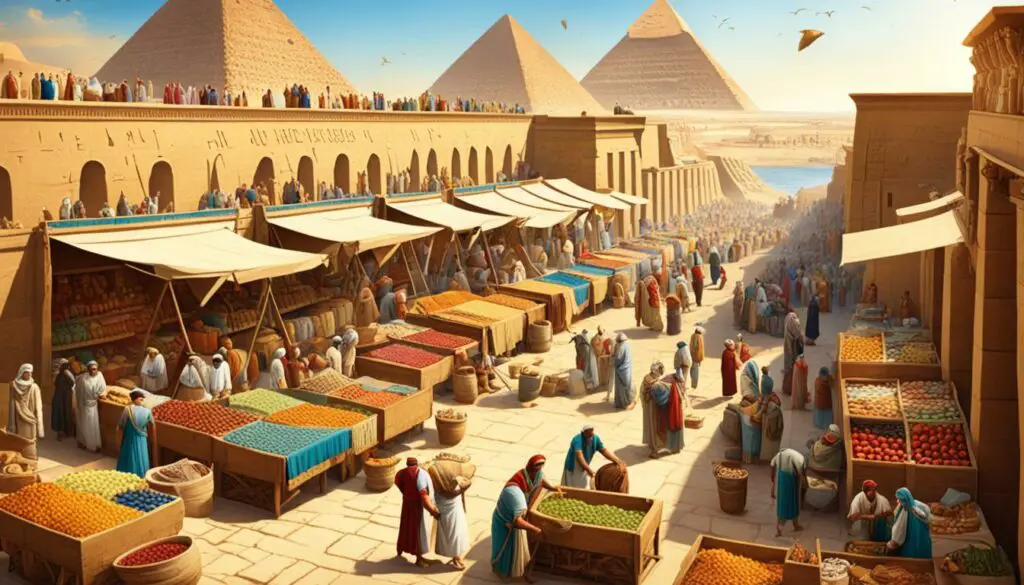
Traded Goods in Ancient Egypt: Resources and Luxury Items
Ancient Egypt was a center of trade, exchanging a variety of goods with different regions. While the land was abundant in grain and known as the “breadbasket” of Rome during the Roman period, there were certain resources that Egypt lacked and had to import through trade. Let’s explore the traded goods that played a vital role in ancient Egyptian trade.
1. Gold
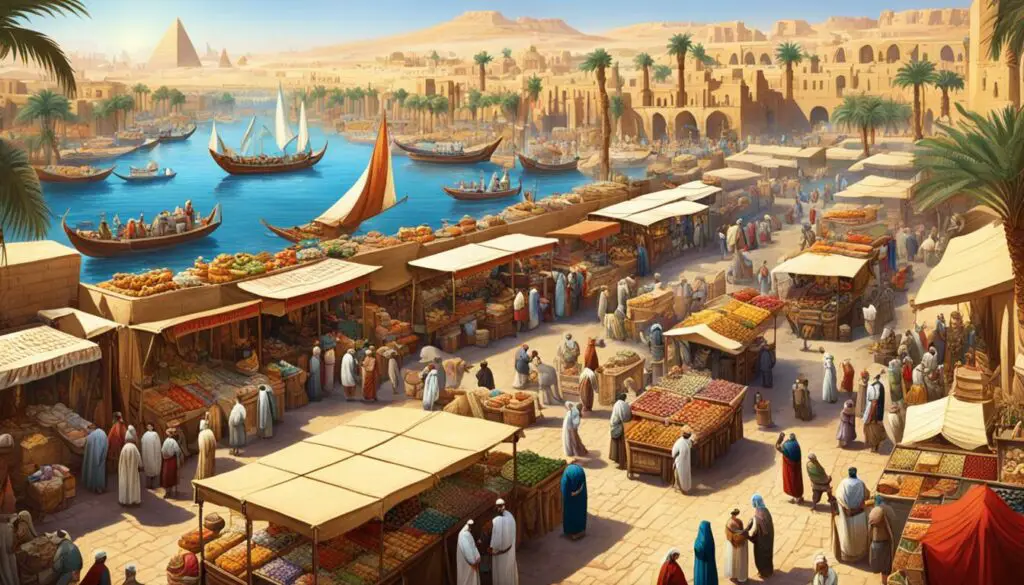
Trade Incentives and Protection in Ancient Egypt
In ancient Egypt, trade played a crucial role in the economy and the acquisition of necessary goods. Although there were no government-sponsored incentives for trade, it was seen as vital for the prosperity of the kingdom. The trade incentives in ancient Egypt were often informal and driven by the desire for valuable resources and luxury items.
Military campaigns were sometimes undertaken to establish trade centers and secure trade routes. Prominent kings like Djer and Khasekhemwy led expeditions to Nubia, a region rich in gold and other valuable resources. By maintaining control over trade centers, these campaigns ensured a steady supply of important commodities.
The ancient Egyptians also recognized the need for trade protection. To safeguard trade routes and resources, the Egyptian kingdom stationed forces along its borders. This presence not only deterred bandits but also ensured the safe passage of traders. Furthermore, trade with other regions often required protection from regional rulers who could impede or disrupt commerce.
The importance of trade protection in ancient Egypt cannot be overstated. It facilitated the flow of goods, maintained stability in the economy, and allowed the kingdom to establish diplomatic relations with neighboring lands.
To grasp the significance of trade incentives and protection in ancient Egypt, it is necessary to examine the interplay between these factors in ensuring a thriving trade network and a prosperous economy.
Ancient Egyptian Trade Incentives
- Desire for valuable resources
- Acquisition of luxury items
Ancient Egyptian Trade Protection
- Military campaigns to secure trade centers and routes
- Presence of Egyptian forces along the borders
- Protection against bandits and regional rulers
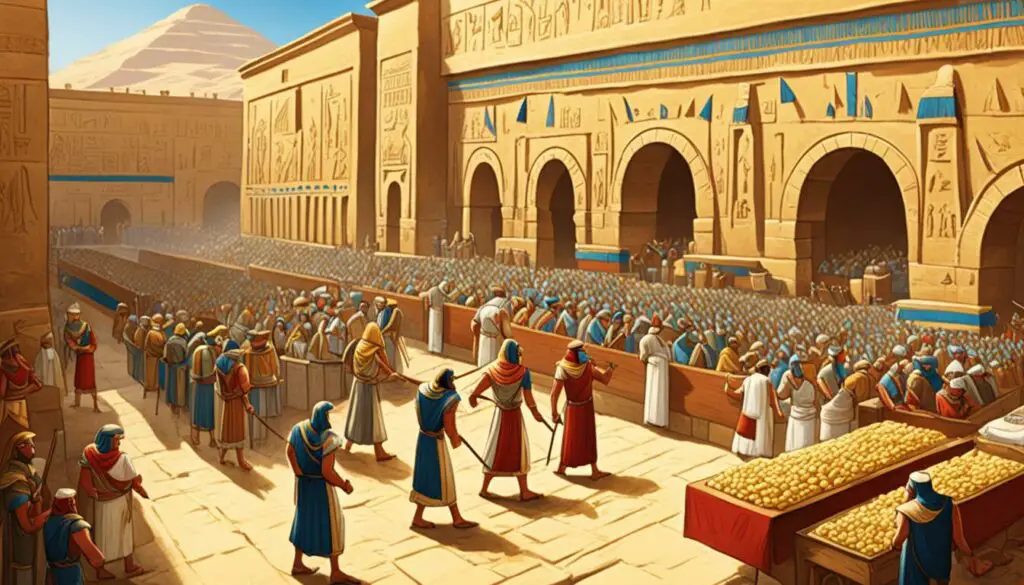
| Trade Incentives | Trade Protection |
|---|---|
| Desire for valuable resources | Military campaigns to secure trade centers and routes |
| Acquisition of luxury items | Presence of Egyptian forces along the borders |
| Protection against bandits and regional rulers |
Evolution of Currency in Ancient Egypt
The currency system in ancient Egypt underwent significant changes over time, reflecting the advancements in trade and economic practices. During the Old Kingdom, ancient Egyptians employed a system of value based on the weights of various metals, such as silver and copper. However, there is no evidence of the use of coined metal during this period.
The introduction of coined money in ancient Egypt occurred in the fifth century BCE, marking a significant milestone in the evolution of currency. Egyptians began importing pieces of silver and gold as a standardized weight, which functioned as a form of standardized currency. This marked a shift from the previous system of value based on metal weights to a more convenient and efficient means of exchange.
The Ptolemaic kingdom, which ruled Egypt from 323 BCE to 30 BCE, played a crucial role in the development of currency in ancient Egypt. The Ptolemies established a single currency policy and minted coins in various metals, including gold, silver, and bronze. These coins provided a standardized and widely recognized medium of exchange, facilitating local and international trade.
However, as the Ptolemaic dynasty neared its end, the debasement of silver coins became a prevalent issue. During the reign of Cleopatra VII, silver coinage suffered from debasement, leading to a decline in its value and ultimately the disappearance of silver coins from circulation.
The Roman Empire, which had a significant influence on Egypt during this period, introduced its currency, the tetradrachms, as the official currency of Egypt. This marked the end of the ancient Egyptian currency system and the adoption of Roman currency as the primary means of exchange.
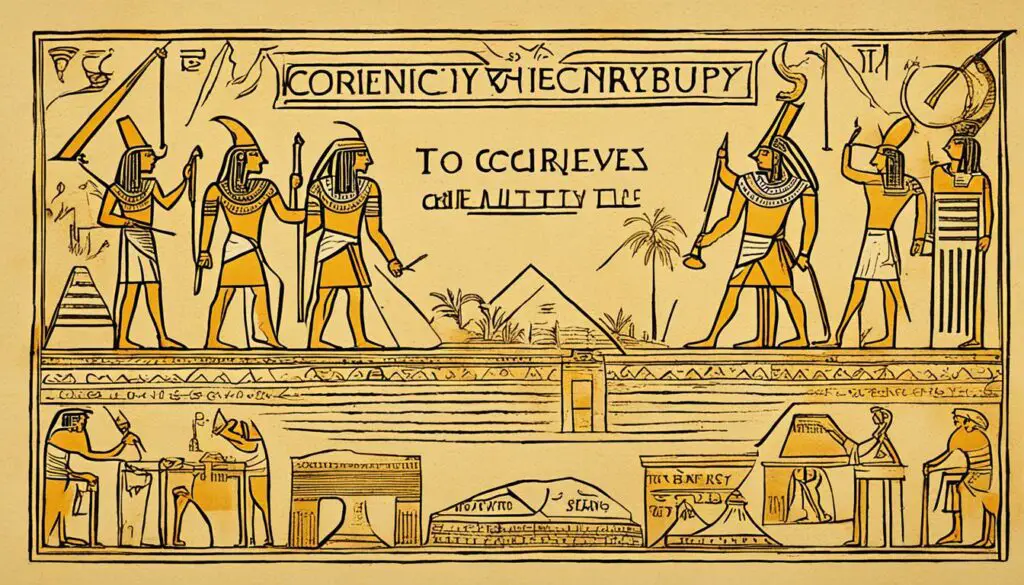
| Period | Currency |
|---|---|
| Old Kingdom | System of value based on metal weights (no coined money) |
| Fifth Century BCE | Imported silver and gold pieces as standardized weight |
| Ptolemaic Kingdom | Minted coins in gold, silver, and bronze |
| End of Ptolemaic Dynasty | Debasement of silver coins, leading to their disappearance |
| Roman Empire | Adoption of Roman currency as the official currency |
Ancient Egyptian Coins: Design and Symbolism
The design of ancient Egyptian coins was influenced by contemporary Greek currencies. The Ptolemaic coinage, in particular, featured symbols associated with the Ptolemaic dynasty, such as an eagle standing on a thunderbolt. These coins also depicted the kings and queens of the dynasty, showcasing their authority and legitimacy.
The process of coin making in ancient Egypt closely resembled that of Seleucid coinage. The first mint for Ptolemaic coins was located in Memphis before being relocated to Alexandria, a city renowned for its economic and cultural significance. The introduction of coins as an official currency in Egypt can be traced back to 500 BCE, marking a transition from using weights of various metals and non-coin forms of silver and gold for trade.
Ancient Egyptian coins carried not only a monetary value but also symbolic significance. They served as a means to disseminate political messages, reinforce the authority of the ruling dynasty, and promote their divine connections. The imagery and inscriptions on the coins reflected the cultural and religious beliefs of ancient Egypt, further emphasizing the importance of symbolism in their design.
The design and symbolism of ancient Egyptian coins provide valuable insights into the artistic and political landscape of the time. Through these coins, we can appreciate the fusion of Greek and Egyptian influences, as well as the cultural and ideological aspirations of the Ptolemaic rulers.
FAQ
Q: How did trade play a role in the ancient Egyptian economy?
A: Trade was crucial for the ancient Egyptian economy as Egypt relied on it for necessary goods and luxuries. Although Egypt was rich in natural resources, trade was necessary to acquire resources like wood, metal, and precious stones that were not readily available. Trade also allowed Egypt to export its surplus grain and become known as the “breadbasket” of Rome during the Roman period.
Q: When did trade begin in ancient Egypt?
A: Trade began in ancient Egypt’s Predynastic Period and continued throughout various periods of Egyptian history. It started between different regions of Egypt even before unification, and by the time of the First Dynasty, trade was established with Mesopotamia.
Q: How did ancient Egyptians value goods and services?
A: Ancient Egyptians valued goods and services using a standard unit called a deben, which functioned as a form of currency. However, for most of its history, ancient Egypt operated on a barter system without cash. The introduction of a cash economy in Egypt occurred after the Persian Invasion of 525 BCE.
Q: What were some of the traded goods in ancient Egypt?
A: Ancient Egypt traded a variety of goods with different regions. Some of the traded goods included grain, gold, wood, ivory, aromatics, and wild animals. During the New Kingdom, there was a focus on luxury goods, and Egypt had extensive trade networks with regions like Cyprus, Crete, Cilicia, Ionia, and the Aegean islands.
Q: Were there any trade incentives and protection measures in ancient Egypt?
A: In ancient Egypt, there were no government-sponsored incentives for trade since the king owned all the land and its products. However, trade incentives were more informal and driven by the desire for valuable resources and luxury items. Military campaigns were sometimes used to establish trade centers and secure trade routes, and the presence of Egyptian forces on the borders ensured the safety of trade routes and resources.
Q: How did the currency system evolve in ancient Egypt?
A: In the Old Kingdom, a system of value based on the weights of various metals like silver and copper was used, but there is no evidence of the use of coined metal during this period. The introduction of coined money began in the fifth century BCE, with the Egyptians importing standardized pieces of silver and gold. The Ptolemaic kingdom established a single currency policy and minted coins in different metals.
Q: What did ancient Egyptian coins look like?
A: The design of ancient Egyptian coins followed contemporary Greek currencies. The Ptolemaic coinage depicted symbols of the Ptolemaic dynasty, such as an eagle standing on a thunderbolt. The kings and queens of the dynasty were also portrayed on coins. The minting process in ancient Egypt was similar to that of Seleucid coinage, and the first Ptolemaic mint was in Memphis before being moved to Alexandria.
